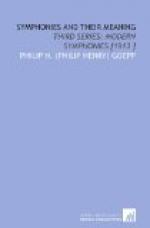Lento in basses of the strings a strain sounds like a basic motive, answered with harmonies in the wood. In further strings lies the full tenor of quiet reflection, with sombre color of tonal scheme. Motives are less controlling probably in Franck than in any other symphonist,—less so, at any rate, than his one
[Music: Lento]
special mood and manner. Yet nowhere is the strict figural plot more faithful in detail than with Cesar Franck.
The theme has an entirely new ring and answer when it enters Allegro after the Lento prelude. The further course of the tune here is in eccentric, resolute stride in the descending scale. Our new answer is much evident in the bass. The Allegro seems a mere irruption; for the Lento prelude reappears in full solemnity. Indeed, with all the title and pace, this seems very like the virtual “slow” movement. A mood of rapt, almost melancholy absorption prevails, with rare flashes of joyous utterance, where the Allegro enters as if to break the thrall of meditation. A very striking inversion of the theme now appears. The gradual growth of phrases in melodious instalments is a trait of Franck (as it is of Richard Strauss). The rough motto at each turn has a new
[Music: Allegro non troppo (Strings) (Wind)]
phase and frequently is transfigured to a fresh tune. So out of the first chance counter-figures somehow spring beautiful melodies, where we feel the fitness and the relevance though we have not heard them before. It is a quality that Franck shares with Brahms, so that in a mathematical spirit we might care to deduce all the figures from the first phrase. This themal manner is quite analogous to the harmonic style of Franck,—a kaleidoscope of gradual steps, a slow procession of pale hues of tone that with strange aptness reflect the dim religious light of mystic musing.
More and more expressive are the stages of the first figures until we have a duet molto cantabile in the strings. Much of the charm of the movement lies in the balance of the new rhythms, the eccentric and the flowing. By some subtle path there grows a song
[Music: Allegro. Molto cantabile]
in big tones of unison, wood and strings and trumpets, that is the real hymnal refrain of the movement. Between this note almost of exultation and all shades of pious dreaming the mood is constantly shifting.
[Music: Allegro]
Another phrase rises also to a triumphant height (the clear reverse of the former tuneful melody) that comes now like a big envoi of assuring message.
Though the whole movement is evenly balanced between Allegro and Penseroso (so far as pace is concerned), the mood of reflection really finds full vent; it has no reason for a further special expression.




